
The Paradox of Pain
The Paradox of Psychological Pain: Why Avoiding Trauma and Grief Makes It Worse
Primary Category: Psychology // User Manual for Your Brain
Authors:
• Vianey Gonzalez B.Sc(Psych) – Licensed Psychologist, Specialty in Crime Victim Trauma Therapy, Neuropsychologist, Certified Deception Professional, Psychology Advisory Panel & Director of the Society of Citizens Against Relationship Scams Inc.
• Tim McGuinness, Ph.D., DFin, MCPO, MAnth – Anthropologist, Scientist, Polymath, Director of the Society of Citizens Against Relationship Scams Inc.
About This Article
Psychological pain cannot be bypassed without consequence. When individuals resist grief, trauma, or emotional suffering, they trap it inside the mind and body, creating long-term distress. Avoidance leads to cycles of anxiety, numbness, and isolation. Healing begins when a person chooses to face pain directly, allowing it to move through the system rather than becoming stuck. This is not a passive process. It involves conscious acceptance, breathwork, mindful attention, and the courage to speak about the pain without asking others to fix it. Philosophical traditions from Stoicism, Buddhism, Taoism, and existentialism agree on this principle, and modern psychological therapies echo the same lesson. Emotional pain needs to be felt, shared, and processed, not avoided. Through this process, individuals develop resilience, post-traumatic growth, and a renewed sense of meaning. Pain becomes part of life’s landscape, not a life sentence. Transformation happens when people choose to lean into suffering instead of fleeing from it.
Note: This article is intended for informational purposes and does not replace professional medical advice. If you are experiencing distress, please consult a qualified mental health professional.

The Paradox of Psychological Pain: Why Avoiding Trauma and Grief Makes It Worse
Why is Psychological Pain a Paradox?
Psychological pain is an unavoidable part of life. It appears in moments of trauma, grief, betrayal, or personal loss. Unlike physical pain, psychological pain does not always have a clear source or simple treatment. It exists in the mind, but it also affects the body. It changes mood, disrupts sleep, and rewires the nervous system. People often describe psychological pain as a deep ache, a sense of emotional collapse, or a wound that refuses to close. It touches every part of life, including memory, relationships, and identity.
At the core of trauma and grief lies a difficult truth. The more someone tries to avoid pain, the worse that pain becomes. Attempts to suppress emotions create new forms of suffering. Denial, distraction, or emotional numbing may offer temporary relief, but they lead to longer-term problems. People who resist grief often find themselves stuck in cycles of anxiety or depression. Trauma survivors who avoid emotional processing may develop chronic stress, somatic pain, or emotional shutdown. This creates a paradox. Avoidance feels like protection, but it traps the mind and body in prolonged suffering.
The opposite path leads to healing. When a person chooses to face pain directly, without running from it, something changes. By allowing grief and trauma to be felt fully, the nervous system can begin to process the experience. Emotional pain is not eliminated, but it becomes part of a natural healing cycle. Feelings move through the body instead of becoming stuck. Acceptance creates space for recovery. Over time, resilience grows in the place where resistance used to live.
This idea is not just a modern psychological insight. It is a lesson taught across time and cultures. Ancient philosophers, Eastern spiritual traditions, and modern therapy models all point to the same principle. Pain is part of life, and avoidance turns it into something worse. Acceptance transforms pain into growth. This is not easy, but it is necessary.
The goal of this article is to explore why this is true. The following sections will explain how avoidance deepens suffering and why acceptance offers a path to healing. The article will draw from psychology, philosophy, and cultural wisdom traditions to show how this paradox works. It will also introduce practical approaches that help people move from resistance to acceptance. Techniques from therapies like Acceptance and Commitment Therapy (ACT), somatic experiencing, and mindfulness all reflect this wisdom. These methods teach individuals to lean into pain, not to escape it, because that is how healing begins.*
The Psychological Trap of Pain Avoidance
The Problem of Suppression
Pain avoidance is a natural human response. When people experience trauma or grief, their first instinct is often to shut the pain down. The mind and body attempt to protect themselves by suppressing feelings, denying the depth of the experience, or distracting attention away from the wound. This reaction feels like relief at first. Numbing out or pushing pain aside gives the illusion of control. It creates a temporary distance from suffering, which the brain interprets as safety.
The problem is that avoidance does not resolve emotional pain. It traps it. Suppression, denial, and distraction are short-term strategies that often lead to long-term consequences. Emotional pain does not disappear when ignored. It stores itself in the mind and body, waiting for an opportunity to surface again. This is why so many trauma survivors find themselves reliving moments of pain in unexpected ways, sometimes years after the original event. The nervous system holds onto trauma like a file left open on a computer. The system never completes the task because the feelings were never fully processed.
Avoidance can take many forms. Emotional suppression involves pushing away grief or fear, refusing to acknowledge what happened. Denial is another version of this, where the mind pretends that everything is fine, even when the evidence says otherwise. Distraction is more subtle but equally harmful. People fill their time with work, social media, alcohol, or constant activity to avoid sitting still with their feelings. These coping methods are understandable. They come from the survival instinct. The mind seeks to escape suffering at all costs. Unfortunately, these strategies do not lead to healing. They create what psychologists call secondary suffering.
Secondary suffering happens when the attempt to avoid pain creates new problems. Suppressing grief can lead to chronic anxiety because the mind remains on high alert, trying to keep emotions locked away. Denial can cause emotional numbness, leaving people disconnected from both pain and joy. Distraction can become addiction when people use food, alcohol, gambling, or other compulsions to keep their minds busy. Each of these outcomes adds more layers of suffering to the original pain.
Trauma psychology confirms this pattern. Studies on post-traumatic stress disorder show that avoidance behaviors maintain trauma symptoms rather than resolving them. When people avoid reminders of their trauma, they prevent their brain from learning that the danger has passed. This keeps the survival system stuck in overdrive. Nightmares, flashbacks, and hypervigilance continue because the trauma has not been processed and integrated. Avoidance interrupts healing by keeping the brain locked in the past.
The Loop of Repression and Emotional Residue
Unprocessed grief and trauma do not disappear just because someone refuses to think about them. They linger in the nervous system as emotional residue. This residue can surface in the body through somatic symptoms. People may develop chronic muscle tension, headaches, stomach problems, or autoimmune issues without realizing that unresolved emotional pain is involved. The nervous system holds trauma at a physical level, creating patterns of stress that do not resolve on their own.
Intrusive thoughts are another consequence of unprocessed trauma. Even when the conscious mind tries to avoid certain memories, the subconscious continues to replay them. Flashbacks, sudden emotional reactions, and vivid mental images appear without warning. These are signs that the mind is still trying to process the unresolved experience. Suppression delays this process, but it cannot stop it completely.
Emotional shutdown often follows prolonged avoidance. People who repress grief or trauma may find themselves feeling flat, numb, or disconnected from life. They lose the ability to experience joy or connection because the same mechanisms that block pain also block pleasure. Emotional shutdown is the nervous system’s way of trying to stay safe, but it creates a life of limitation. Instead of feeling less pain, the person ends up feeling less of everything.
Bessel van der Kolk describes this in The Body Keeps the Score. He explains how trauma imprints itself on the body, even when the mind tries to forget. The body remembers what the mind ignores. This is why trauma survivors often experience somatic symptoms long after the event has passed. The unresolved energy of the trauma remains stored in muscles, posture, breath patterns, and nervous system responses. Without proper processing, the freeze response can become a permanent way of living.
This loop of repression and emotional residue creates a feedback cycle. The more someone avoids pain, the more the nervous system holds onto it. Over time, this leads to chronic stress, burnout, and emotional exhaustion. Avoidance becomes a prison. The key to breaking this cycle is not to suppress pain but to face it. Healing requires moving through the pain, not around it.
Philosophical Views on Pain, Avoidance, and Acceptance
Philosophy has long grappled with the human tendency to avoid pain. Across cultures and centuries, thinkers have warned that fleeing from discomfort creates deeper suffering. The wiser path is acceptance. This section explores how different philosophical traditions approach the dilemma of pain avoidance versus pain acceptance. Each tradition offers unique tools for facing trauma, grief, and psychological hardship without adding unnecessary suffering.
The Stoic Perspective
Stoic philosophy offers some of the clearest teachings on pain and acceptance. Epictetus, a former slave who became one of the most respected Stoic teachers, wrote extensively about the difference between what people can control and what they cannot. He taught that pain is often unavoidable, but suffering is a choice. When someone tries to resist reality, they create additional suffering.
One of his most famous teachings captures this idea directly: “Do not seek for things to happen the way you want them to; rather, wish that what happens happen the way it happens: then you will be happy.” This is not a call for passive resignation. It is a call to align one’s expectations with reality. Pain is part of life. Fighting against that truth creates more distress than the pain itself.
Marcus Aurelius, another Stoic thinker, echoed this in his private journal, now known as Meditations. He reminded himself daily that hardship is part of nature’s design. Trying to avoid it is like trying to stop winter or wishing the sun would not set. He wrote, “If you are distressed by anything external, the pain is not due to the thing itself, but to your estimate of it; and this you have the power to revoke at any moment.” This teaching suggests that suffering comes from mental resistance, not from the pain event itself.
Stoics practiced ‘premeditatio malorum,’ or negative visualization. They imagined losing what they loved, facing disease, or experiencing public humiliation. This was not morbid thinking. It was preparation. By imagining hardship in advance, they trained the mind to handle it calmly when it arrived. This practice reduced shock, panic, and despair. It created a mindset where pain was expected, accepted, and managed rather than denied or resisted.
Stoicism does not teach people to love pain for its own sake. It teaches them to accept pain as a fact of life and to meet it with dignity. In this view, emotional resilience comes from practicing acceptance, not from chasing comfort or avoiding hardship.
Buddhist Views on Suffering and Acceptance
Buddhism begins with the acknowledgment that suffering is part of life. The First Noble Truth states directly: “Life involves suffering.” In Buddhist teachings, this suffering is called dukkha. It refers not just to physical pain but also to the emotional discomfort of change, loss, and impermanence. Trying to avoid suffering, according to Buddhism, leads to more suffering because it creates attachment to control and comfort.
The Buddha taught that pain is like being struck by an arrow. That first arrow is life itself. Everyone experiences sickness, loss, and death. The second arrow is self-inflicted. It comes when a person resists the first arrow, asking, “Why me?” or “This should not be happening.” That mental resistance creates new layers of pain. The original injury might be unavoidable, but the second arrow is not. Recognizing this pattern allows people to respond differently to hardship.
Mindfulness and equanimity are two Buddhist strategies for dealing with suffering. Mindfulness involves noticing pain without trying to change it. This does not mean giving up. It means staying present with reality instead of escaping into distraction or denial. Equanimity is the practice of maintaining balance, even in the face of difficulty. When people cultivate these qualities, they reduce the mental tension that makes suffering worse.
Buddhism teaches that the root of unnecessary suffering is attachment. People cling to pleasure, status, relationships, and life itself as if they can control them forever. When life changes, grief and trauma feel unbearable because the mind resists letting go. Buddhism offers an alternative path: accept change, accept loss, and accept pain as part of the human condition. In doing so, people lessen the burden of emotional suffering.
Existentialist Philosophy and the Necessity of Pain
Existentialist thinkers have also explored the connection between pain and meaning. Søren Kierkegaard believed that despair comes from avoiding true selfhood. People run from their authentic identity because it feels risky or painful. They distract themselves with comfort, routine, or false certainty. In doing so, they create what Kierkegaard called “despair of possibility.” This is a form of suffering that comes from rejecting life’s inevitable uncertainties.
Friedrich Nietzsche took this idea further with his concept of “amor fati,” which means “love of fate.” Nietzsche argued that true strength comes not from avoiding life’s hardships but from embracing them fully. He wrote, “My formula for greatness in a human being is amor fati: that one wants nothing to be different, not forward, not backward, not in all eternity. Not merely bear what is necessary, still less conceal it, but love it.” This philosophy asks people to stop wishing for a painless life. Instead, they are encouraged to love life exactly as it is, including the suffering it contains.
Viktor Frankl brought this idea into the modern world through his experiences in Nazi concentration camps. In Man’s Search for Meaning, he described how prisoners who found meaning in their suffering were more likely to survive. Frankl believed that life has meaning under all conditions, even the most horrific ones. He wrote, “When we are no longer able to change a situation, we are challenged to change ourselves.” This does not mean accepting cruelty or injustice. It means finding inner purpose even when the external world is unbearable.
Existentialist philosophy teaches that pain is not an obstacle to life’s purpose; it is part of it. Meaning is not found in avoidance. It is found in endurance, reflection, and personal growth through hardship.
Taoist Non-Resistance
Taoism offers a different but related view on pain and acceptance. In Taoist philosophy, life is seen as a flow. Pain, joy, loss, and change are all part of the river of existence. The Tao Te Ching teaches that forcing life to match personal desires creates suffering. Lao Tzu advised, “When I let go of what I am, I become what I might be.” This includes letting go of the desire to avoid pain.
The Taoist principle of wu wei means non-resistance or effortless action. It does not mean doing nothing. It means aligning with the natural course of life rather than fighting against it. When grief arises, Taoism teaches people to let it flow through them like water. Resisting pain is like damming a river. It creates pressure, tension, and eventual collapse. Allowing pain to move naturally leads to healing without added struggle.
Taoist thought suggests that life heals itself when people stop interfering. Grief resolves not because it is suppressed but because it is allowed to complete its course. Pain softens when it is held gently, not when it is fought with force. This philosophy encourages yielding to life’s rhythms rather than imposing rigid expectations on how life should feel.
These philosophical views converge on a single lesson. Pain cannot be avoided without cost. Whether through Stoicism, Buddhism, existentialism, or Taoism, the message is the same. Trying to escape pain leads to deeper suffering. Accepting pain as part of life opens the door to healing, growth, and wisdom.
The Danger of Toxic Positivity and False Encouragement
Modern culture often sends a message that contradicts the wisdom of ancient philosophy. It teaches people to suppress their pain through toxic positivity. This mindset promotes relentless optimism and shallow reassurance, even in the face of real trauma and grief. The idea sounds appealing on the surface: “Look on the bright side, stay positive, everything happens for a reason.” While encouragement has its place, forcing positivity becomes harmful when it denies legitimate emotional pain.
Toxic positivity rejects the natural process of suffering. It tries to replace grief with cheerfulness before the grief has been felt. This creates what psychologists call emotional invalidation. When someone in pain is told to “just be grateful” or “focus on the good,” they receive the message that their real emotions are unacceptable. This can lead to feelings of isolation, shame, and deeper distress.
Philosophically, toxic positivity ignores the reality of suffering. It tries to bypass life’s darker moments by pretending they do not exist. This mindset opposes the teachings of the Stoics, Buddhists, existentialists, and Taoists. These traditions do not tell people to pretend that everything is fine. They tell people to face what is real, including pain, with courage and acceptance.
From a psychological perspective, toxic positivity blocks emotional processing. Research shows that avoidance of negative emotions prevents healing. When individuals are pressured to be positive too soon, they suppress grief and trauma instead of working through it. This creates a backlog of unresolved emotion that can surface later as anxiety, depression, or physical symptoms. Studies on emotional suppression confirm that avoiding sadness or fear leads to worse outcomes in mental health, not better.
False encouragement also creates unrealistic expectations. When people believe they must move on quickly or bounce back stronger, they feel like failures when grief lingers. Real healing does not follow a tidy timeline. It happens in waves. Some days feel lighter. Other days feel heavy. Pressuring someone to feel better before they are ready makes the pain more complicated.
Toxic positivity can also lead to self-blame. When someone feels miserable despite positive thinking, they may believe they are doing something wrong. This belief increases suffering. The person thinks, “If I am still sad, it must be my fault. I must not be trying hard enough to be happy.” In reality, emotional pain is not a sign of failure. It is a normal response to loss and trauma.
Spiritual bypassing is another form of toxic positivity. This happens when people use spiritual ideas to avoid dealing with emotional pain. Phrases like “everything happens for a reason or this is part of a greater plan” can shut down real conversations about grief. While these ideas may offer comfort to some, forcing them onto others creates pressure to skip over the raw, painful parts of human experience.
Philosophical traditions caution against this kind of avoidance. The Stoics teach people to prepare for hardship, not deny it. Buddhism warns against attachment to comfort and control. Existentialism urges people to find meaning in the struggle itself, not in escaping it. Taoism reminds people to flow with life’s changes, not to resist or cover them with false brightness.
Authentic healing requires space for all emotions, not just the pleasant ones. Accepting grief, sitting with sorrow, and allowing pain to unfold are necessary parts of recovery. Encouragement becomes helpful when it respects this process. Real support does not say “cheer up” or “get over it.” It says I will sit with you while you feel this. It says, “This is hard, and you do not have to hide that.”
Rejecting toxic positivity does not mean rejecting hope. It means grounding hope in reality. Real hope says, “This hurts now, and it may hurt for a while, but you will find your way through it because you are human and capable, not because you pretend the pain is gone.” This kind of hope respects both the darkness and the light.
By understanding the dangers of false encouragement, individuals can avoid the trap of shallow optimism. They can replace it with deeper acceptance, which leads to genuine healing. Pain needs acknowledgment, not dismissal. Grief needs time, not shortcuts. Emotional honesty creates the conditions for growth. Pretending pain away only makes it louder later.
The lesson from ancient philosophy and modern psychology is clear. Avoiding pain prolongs suffering. Accepting pain with openness and compassion is the true path to resilience.
Modern Psychology Echoes Ancient Wisdom
Modern psychology increasingly validates what ancient philosophies have taught for centuries. Psychological pain cannot be eliminated by avoidance. It must be faced directly. This truth forms the foundation of many therapeutic approaches used today. Contemporary therapy does not try to erase pain. It teaches individuals how to live with pain in a way that reduces suffering and restores life balance.
Acceptance and Commitment Therapy (ACT)
Acceptance and Commitment Therapy, known as ACT, is one of the clearest examples of this principle. ACT teaches clients to accept emotional pain rather than suppress or avoid it. The core idea is simple but profound. Life involves suffering. People cannot control every event, but they can control how they respond to it.
ACT encourages cognitive defusion. This practice helps clients distance themselves from their thoughts without trying to change or suppress them. Instead of saying, I am a failure, a person learns to say, I am having the thought that I am a failure. This shift creates space between the individual and the thought. It reduces the power of painful emotions by allowing them to exist without letting them dictate behavior.
Mindfulness is another central part of ACT. Clients are taught to sit with discomfort, observe it without judgment, and allow it to pass naturally. The goal is not to feel good but to feel fully. Pain is allowed to exist without resistance. This process reduces secondary suffering, the additional pain caused by fighting against emotional discomfort.
ACT also focuses on values. Clients are encouraged to identify what matters most to them and to take committed action toward those values, even when it involves emotional pain. This approach shifts the focus from trying to feel better to trying to live better. Pain becomes part of the journey, not an obstacle to avoid.
The creators of ACT, including Steven C. Hayes, emphasize that avoidance leads to psychological entanglement. Acceptance, on the other hand, leads to freedom. Clients learn that pain is not the enemy. It is part of life. By making room for it, they can build a life filled with purpose and meaning, even in the face of grief or trauma (Hayes et al., 2011).
Exposure Therapy and Trauma
Exposure therapy provides another example of modern psychology embracing the necessity of facing pain. This method is often used in trauma treatment, especially for post-traumatic stress disorder (PTSD). The goal is not to avoid traumatic memories but to gradually re-experience them in a safe and controlled setting.
Trauma creates loops in the nervous system. Individuals avoid triggers because they fear the emotional overwhelm that comes with them. Unfortunately, avoidance reinforces the trauma loop. Each time a person escapes a trigger, the brain learns that the trigger is dangerous. This keeps the fear response alive.
Prolonged Exposure Therapy, developed by Edna Foa and colleagues, helps break this loop. Clients are guided to confront traumatic memories, images, or situations without running away. By staying with the experience, the brain learns that the memory is not a current threat. Over time, this reduces the emotional charge of the trauma.
Exposure therapy is not about forcing pain or retraumatizing the individual. It is about creating a controlled environment where the person can feel the emotions they have been avoiding. This process allows the brain to process the trauma properly. The memory becomes integrated rather than repressed.
By facing the pain directly, individuals learn that they can survive it. This reduces fear, builds resilience, and restores a sense of control. Avoidance keeps the trauma alive. Exposure helps it transform (Foa, Hembree, & Rothbaum, 2007).
Somatic Therapy and Embodied Trauma
Trauma is not just a mental experience. It lives in the body. Bessel van der Kolk and Peter Levine have shown that unprocessed trauma often becomes stored in muscle tension, posture, and physical sensations. When people avoid emotional pain, they also avoid the body states associated with that pain. This creates a split between mind and body that prolongs suffering.
Somatic experiencing, developed by Peter Levine, addresses this problem. The therapy focuses on gentle, gradual contact with body-based distress. Clients learn to notice sensations without becoming overwhelmed. They build tolerance for discomfort by working slowly, respecting the body’s signals.
Trauma often interrupts the natural discharge of survival energy. In animals, this energy is released through shaking, movement, or breathing. In humans, social expectations and fear of pain often block this process. Somatic therapy reopens the door for release. Clients may experience small tremors, shifts in posture, or changes in breathing as the body lets go of stored trauma.
By reconnecting with the body, individuals learn that their physical sensations are safe to feel. They no longer need to clamp down on emotional or physical pain. This approach restores a sense of safety in the body, which is critical for healing from trauma.
Somatic therapy also reduces the risk of retraumatization. It does not force clients to relive traumatic events all at once. Instead, it works through small, manageable steps. This teaches the nervous system that it is possible to feel pain and still be okay. Over time, the body learns to complete the defensive responses that were interrupted by trauma (Levine, 1997).
Integration of Body and Mind
Modern psychological approaches like ACT, exposure therapy, and somatic experiencing all teach the same lesson found in ancient philosophy. Avoidance of pain deepens suffering. Acceptance of pain leads to healing. These therapies help clients move from fear-based reactions to mindful engagement with life.
The work is not about eliminating pain. It is about transforming the relationship with pain. Clients learn to carry their grief and trauma with compassion rather than resistance. They develop new ways to experience emotional and physical sensations without shutting down.
These methods create lasting change because they address both the mind and the body. Emotional pain is no longer seen as an enemy to fight. It becomes a signal to listen to, a teacher to learn from, and a companion on the path toward meaning and connection.
The Path to Healing: Leaning into Pain
What It Means to Lean Into Pain
Leaning into pain means staying present with emotional suffering without trying to escape, fix, or numb it. It requires allowing the experience of pain to exist fully, even when every instinct says to push it away. This practice is not passive endurance. It is active engagement with reality. It involves noticing the sensations, emotions, and thoughts that arise and remaining with them without judgment.
Buddhist meditation teaches this principle through mindfulness and equanimity. Practitioners are taught to observe pain like a wave. They notice it rising, peaking, and falling without trying to control it. Pain becomes part of the landscape of experience, not a signal to flee. The practice develops a state of presence where the individual can feel discomfort without collapsing under it.
Stoic philosophy echoes the same lesson. Marcus Aurelius wrote, “If you are distressed by anything external, the pain is not due to the thing itself, but to your estimate of it; and this you have the power to revoke.” The Stoics trained their minds to accept reality as it is, not as they wished it to be. This included accepting emotional and physical pain. They believed that by leaning into suffering, individuals developed resilience. Fear of pain weakens character. Courage in the face of pain strengthens it.
Psychological resilience grows when a person faces suffering directly. Avoidance teaches the brain that pain is dangerous. Presence teaches the brain that pain is survivable. When individuals lean into pain, they reduce the fear surrounding it. This opens the door to healing.
Emotional Alchemy: Transforming Pain Into Growth
Acceptance does more than reduce suffering. It transforms pain into a catalyst for change. When individuals stop resisting grief or trauma, they can begin to integrate it into their life story. This process is known as post-traumatic growth. It does not mean the trauma was good or that the pain was desirable. It means the individual finds a way to build meaning from the experience.
Post-traumatic growth includes several possible outcomes. People may develop a greater appreciation for life. They may deepen their relationships or discover new personal strengths. Some find a renewed sense of purpose or spiritual awareness. This transformation happens not because the pain disappears, but because it becomes part of a larger narrative of survival and meaning.
Tedeschi and Calhoun, researchers who developed the post-traumatic growth model, emphasize that this process does not happen through avoidance. It happens through deliberate engagement with emotional pain. By processing grief, trauma, and suffering, individuals learn to live with the pain in a new way. They carry it forward as part of their identity, but not as a burden that controls them (Tedeschi & Calhoun, 2004).
Pain creates a space where growth becomes possible. It strips away illusions and confronts the individual with fundamental questions about life, death, and purpose. Those who lean into this experience often emerge with new clarity about what matters most.
Practical Tools for Practicing Acceptance
Leaning into pain is not a vague idea. It involves specific practices that help the mind and body stay present with discomfort. These tools are simple but powerful. They create a structure for allowing pain without being overwhelmed by it.
Mindfulness meditation is one of the most effective methods. It teaches individuals to observe their thoughts and feelings without attachment. In mindfulness practice, the goal is not to feel better. The goal is to notice what is happening in the present moment. Pain is treated as part of the experience, not something to remove. Over time, this builds the capacity to stay with difficult emotions without shutting down.
Journaling is another tool. Writing down painful thoughts and feelings without editing allows for emotional processing. The act of putting words on paper creates a safe container for grief and trauma. It helps organize thoughts, clarify emotions, and reduce internal chaos. Journaling does not fix the pain, but it helps make it visible and manageable.
Talking openly in support groups or therapy provides connection during times of suffering. Speaking the truth about pain reduces isolation. It helps individuals realize they are not alone. Shared vulnerability creates a sense of community. It normalizes emotional struggles and offers support during the hardest moments.
Breathwork is a somatic practice that anchors the body during emotional waves. Deep, slow breathing activates the parasympathetic nervous system. This helps calm the body even when the mind feels flooded. Breathwork teaches the system that it is possible to stay present without becoming overwhelmed. It creates a bridge between emotional intensity and physical grounding.
Jon Kabat-Zinn, the founder of Mindfulness-Based Stress Reduction, teaches that acceptance is the heart of healing. In his work, he reminds people that life includes “the full catastrophe”, joy, pain, love, loss, and everything in between. Learning to face the full range of experience without resistance is the key to resilience (Kabat-Zinn, 1990).
Each of these tools supports the practice of leaning into pain. They offer structure, guidance, and support for navigating emotional suffering. They remind individuals that pain is not the enemy. Avoidance is. By staying present with discomfort, people develop the capacity to heal, grow, and find meaning in the life they are living now.
Letting Emotional Pain Flow Through You Without Getting Stuck
Emotional pain is not meant to stay trapped in the body. It is meant to move through the system like a wave. When individuals choose to feel pain rather than avoid it, they begin a process of emotional digestion. The goal is not to hold onto suffering but to allow it to flow through naturally. This requires conscious engagement, not passive endurance. It means learning how to feel the pain fully without becoming frozen or overwhelmed by it.
Emotional energy, like physical energy, follows natural cycles. It rises, peaks, and eventually subsides. Problems occur when individuals interrupt this cycle by resisting the experience. They brace against grief, tighten against sadness, or distract themselves from sorrow. This resistance traps the pain in the system, causing it to linger longer than necessary. When pain cannot move, it creates emotional congestion, leading to anxiety, numbness, or chronic distress.
Letting emotional pain flow starts with willingness. The first step is to say yes to the experience. This does not mean liking it or wanting it. It means acknowledging its presence without trying to push it away. When pain is met with openness, it often softens on its own.
The breath plays a central role in this process. Shallow breathing signals the nervous system to tighten. Deep, slow breathing tells the body it is safe to feel. Breath acts as a container for emotional energy. It provides rhythm and movement, helping the pain circulate rather than stagnate. When individuals breathe through pain, they allow their body to process it naturally.
Physical awareness is also important. Emotional pain often shows up in the body as tension, constriction, or heaviness. By noticing where the pain lives in the body, individuals can give it attention without judgment. They can gently scan for sensations, observing them with curiosity. Does the pain feel like heat, pressure, or coldness? Is it sharp, dull, or buzzing? Paying attention to these details allows the body to metabolize the emotional energy rather than lock it away.
Movement can help pain flow. This does not need to be exercise. It can be as simple as shifting posture, stretching gently, or walking slowly. Movement reminds the body that it is not stuck. It activates the muscles and nervous system in ways that promote release. Trauma and grief often cause people to freeze physically. Moving breaks this pattern and signals to the brain that the system is ready to process and let go.
Expression is another way to keep emotional pain moving. Talking, crying, writing, or creating art provides an outlet. These actions give form to the pain so it can exit the body and mind. When individuals express their feelings, they turn raw emotion into something shared and understandable. This helps prevent the pain from becoming internalized or repressed.
Setting boundaries around emotional processing is also part of the practice. Leaning into pain does not mean drowning in it. It means creating structured time and space to feel fully, then returning to daily life. Some people find it helpful to schedule moments for reflection, journaling, or mindful sitting. Afterward, they engage in grounding activities, like spending time in nature, connecting with friends, or completing simple tasks. This teaches the system that pain has a time and place, but it does not control every moment.
Self-talk matters during this process. The mind will sometimes say, I cannot handle this or This will never end. These thoughts are normal but not true. Pain feels permanent when it is at its peak, but it changes when allowed to move. Using gentle reminders like, This is a wave, or, Let it move through me, helps maintain perspective.
Visualization can also support emotional flow. Some people imagine their pain as a current of water passing through them. They see it entering, moving through the chest or stomach, and exiting. Others picture the pain as a storm that will pass if they remain grounded. These images help the mind cooperate with the body’s natural processing.
Somatic therapies often teach this approach. Practitioners guide individuals to pendulate between pain and safety. This means feeling the distress for a moment, then returning to a sense of calm. The cycle repeats in gentle waves. This method prevents overwhelm while still allowing the pain to move through. It trains the nervous system to handle intense emotions without shutting down.
Letting emotional pain flow through the system is not about fixing or changing the feeling. It is about allowing the natural cycle of emotion to complete itself. When individuals stop resisting, the body and mind often know what to do. Pain rises, moves, and eventually softens. Sometimes it leaves completely. Sometimes it returns in smaller waves. Each time, the system learns that pain is survivable and temporary when it is allowed to move.
This practice builds emotional resilience. It teaches that pain is not an enemy to be defeated. It is a process to be experienced and honored. By letting the pain flow, individuals transform suffering from a prison into a passage. They allow life to move forward, carrying both the lessons and the healing that come from truly feeling.
Learning How to Talk About the Pain Without Asking Others to Fix It
Sharing emotional pain is one of the hardest parts of recovery. Many people fear that if they speak about overwhelming grief or trauma, they will burden others. Some believe that their pain is too big to explain or too complex to understand. Others worry that if they start talking, the pain will take over the conversation or flood the relationship. These fears are normal, but they can lead to isolation. Learning how to share pain without asking others to fix it is an essential part of healing.
Pain needs witnesses. Emotional suffering softens when it is acknowledged by another person. This does not mean that someone else can take the pain away. It means they can help hold it for a moment, offering presence instead of solutions. Being seen and heard in the middle of suffering creates relief that no distraction or suppression can match.
The first step is deciding to speak. This often feels like the hardest part. Many people carry silent pain because they do not know how to begin the conversation. They might think, How do I even explain this? or What if the other person runs away? The truth is that pain does not need to be explained perfectly. It only needs to be expressed honestly.
Starting with a simple, clear statement helps. Phrases like, “I am in more pain than I know how to handle right now,” or, “I do not need advice, I just need someone to sit with me while I say this,” open the door to connection. These sentences tell the listener exactly what is needed: presence, not problem-solving.
It is helpful to explain the purpose of the conversation upfront. Some people say, “I need to say this out loud so I am not carrying it alone.” Others say, “I do not need you to fix anything. I just need you to listen while I get this out.” This sets a boundary that protects both people. It tells the listener that their role is to witness, not to heal or rescue.
When the pain feels too big for words, starting with sensations can help. Saying, “My chest feels tight and I cannot breathe fully,” or “It feels like there is a heavy stone in my stomach,” makes the experience more shareable. This approach bypasses the need for perfect language. It invites the listener into the experience without forcing an explanation that feels impossible.
Some people find metaphors useful when sharing deep pain. They might say, “It feels like I am drowning and I cannot find the surface,” or “It feels like a wound that keeps reopening.” These images help the other person understand the depth of feeling without needing every detail of the story. Metaphors create bridges between inner experience and shared human understanding.
Honesty is key. It is okay to say, “I do not even know what I am feeling right now, but I know I need someone to hear me say that.” It is okay to say, “I feel like I am falling apart,” or “I feel lost and scared.” Pain does not need to be presented in neat packages. It needs to be real.
The person listening cannot take the pain away, but they can offer safety. A calm, steady presence gives the nervous system something to anchor to. When someone listens without interrupting, judging, or rushing to fix the problem, they create space for the speaker to breathe again. This process reduces isolation. It reminds both people that pain is part of life, but it does not have to be carried alone.
Sharing pain also involves knowing when to pause. Emotional conversations can feel overwhelming if they go on too long without grounding. It is helpful to check in with oneself during the process. Asking, “Do I need a break? Do I need to rest for a moment?” creates safety for both the speaker and the listener. It teaches the system that intense emotions can be processed in manageable pieces.
Sometimes the pain does not need to be spoken in full detail. Sitting quietly with someone, crying openly, or allowing silence to hold the space can be just as powerful as words. Presence matters more than precision. The act of being together in the experience makes the difference.
Writing can also be a bridge to speaking. Some people find it easier to write a letter or message explaining their pain before having a conversation. This allows time to find words without pressure. The written message can say, “I need to share something that is hard to talk about. Can we make time for that?” or “I have written this down because it is too heavy to say all at once.”
How to Share the Pain When the Heart Feels Too Full
When emotional pain becomes overwhelming, it often silences the person carrying it. The weight feels too heavy to describe. Words seem too small. Some individuals withdraw, afraid that their pain will burden others or be misunderstood. Others do not know how to begin. They fear judgment, rejection, or the possibility that sharing their pain will make it feel even more real. Yet pain that stays hidden grows heavier. It needs space to move, not only within the body, but between people.
The act of sharing pain is not about asking someone to fix it. It is not a request for advice or solutions. It is a way of saying, “I am carrying something too large alone. Will you sit with me while I hold it?” The goal is not to erase the pain, but to allow it to be witnessed. Being seen in sorrow is one of the most human needs. It reminds the suffering person that they are still part of the world.
To share pain, a person first needs to believe that they are allowed to do so. Emotional pain is not weakness. Grief is not a problem to be solved. Trauma is not a story that must be sanitized before it is told. These experiences are part of life. When they are kept in silence, they grow sharper. When they are spoken aloud, they begin to soften.
Finding the words can still feel difficult. The truth may feel too large to say all at once. In those moments, it helps to start small. A person might begin with, “I am hurting more than I know how to explain.” Or, “I do not need you to fix anything. I just need someone to hear me.” These sentences open the door. They do not require full storytelling. They invite the listener to step into the space gently.
The person listening plays an equally important role. Many people rush to offer comfort, reassurance, or solutions. These responses often come from love, but they can shut down the conversation. The person in pain may feel unseen, as if their experience is being brushed away. What they often need most is presence, not answers.
To support someone in pain, the listener can say, “I am here. I want to understand. Take your time.” They can sit quietly, letting silence make space for what needs to be said. They do not need to interpret, correct, or improve the experience. Their job is to hold the space. When someone shares emotional pain, the listener becomes a container, large enough to hold what the speaker cannot hold alone.
For the person speaking, it may help to write down what they want to say before they say it. Journaling, voice notes, or letters offer a first step. Sometimes it is easier to write, “This is the part I have never told anyone,” than to speak it directly. These practices make the unspeakable start to feel more familiar. They create a bridge between silence and expression.
Some people choose to share pain with a therapist or support group first. These settings offer structure, privacy, and trained presence. Others choose a friend or loved one who has shown emotional steadiness in the past. What matters most is the ability to be heard without being rushed. The relationship must have space for the truth to exist without interruption or dismissal.
The fear of overwhelming others is real. People who carry deep pain often worry that they will damage or push others away. The truth is that human beings are more capable of holding sorrow than they often believe. When approached with honesty and care, most people respond with compassion. They may not always understand every detail, but they understand the feeling of suffering. That shared humanity becomes the connection.
Sometimes pain comes in waves, and the need to speak comes and goes. A person may feel ready one day and silent the next. This is normal. Emotional expression is not linear. It unfolds in cycles. The person speaking does not need to rush or follow a script. They can share as much or as little as they choose.
The most important part of sharing emotional pain is not the words. It is the act of reaching out. Saying, “Can you be with me in this?” is an act of courage. It breaks the illusion of isolation. It allows healing to begin in the presence of another.
Sharing pain also reminds the speaker of their own aliveness. Speaking truth requires breath, attention, and emotional risk. In doing so, the person proves to themselves that they are still here. They are still worthy of being heard. They are not disappearing into the pain. They are emerging from it, voice-first.
When emotional pain becomes too heavy to hold alone, it becomes necessary to let it be seen. Not to be fixed. Not to be taken away. Just to be held in the light of another person’s presence. That act of speaking, and of being heard, begins to change everything. Not by removing the pain, but by making space for the one who carries it to rest.
Conclusion
Psychological pain is part of the human condition. It arises from trauma, grief, betrayal, loss, and the disruptions of life that no one can control. The mind instinctively tries to avoid this pain. It seeks relief through distraction, denial, or emotional suppression. That reflex is understandable, but it does not work. Avoidance turns pain into suffering that lasts longer and cuts deeper.
The paradox of pain is clear. The harder someone tries to escape emotional suffering, the more it consumes them. Trauma remains locked in the body. Grief circles back through intrusive thoughts, somatic symptoms, and emotional shutdown. The cycle repeats because the system never completes the natural process of feeling, processing, and releasing.
Across time, cultures, and philosophies, the solution has been the same. The path to healing requires acceptance. It demands the courage to sit with pain, to let it move through the system, and to speak it aloud without fear of judgment. Ancient Stoics, Buddhist teachers, existential philosophers, and Taoist sages all taught this truth in different ways. Modern psychology has confirmed it through research and therapy. Acceptance and Commitment Therapy, somatic experiencing, and exposure-based treatments all reflect this wisdom in clinical practice.
Leaning into pain does not mean giving up. It means allowing grief, trauma, and sorrow to exist without running from them. It means learning to let emotional waves rise and fall naturally. It means breathing through discomfort, feeling it fully, and trusting that it will pass. This process builds resilience, not weakness. It transforms emotional pain from a life sentence into a passage toward growth.
Sharing pain is part of this healing. Speaking about suffering allows it to move out of isolation and into connection. Saying, “I need someone to hear me,” creates space for the pain to be seen without being solved. It reminds the person in pain that they are not alone. Being witnessed in sorrow reduces the burden. It makes room for rest, integration, and recovery.
This process is not easy, but it is necessary. Life will always contain suffering. Trying to escape it creates more. Accepting it with honesty and compassion creates the possibility of transformation. Pain is not the enemy. Avoidance is. Healing begins when individuals stop resisting their grief and begin to carry it with awareness, courage, and connection.
Learn More
Reference
- Levine, P. (1997). Waking the Tiger: Healing Trauma. [PDF]
- Hayes, S. C., Strosahl, K. D., & Wilson, K. G. (2011). Acceptance and Commitment Therapy: The Process and Practice of Mindful Change.
- Foa, E. B., & Kozak, M. J. (1986). Emotional processing of fear: Exposure to corrective information. Psychological Bulletin.
- Van der Kolk, B. (2014). The Body Keeps the Score: Brain, Mind, and Body in the Healing of Trauma.
- Frankl, V. E. (1946). Man’s Search for Meaning.
- Tedeschi & Calhoun, 2004. Posttraumatic Growth: Conceptual Foundations and Empirical Evidence
- Kabat-Zinn, J. (1990). Full catastrophe living: Using the wisdom of your body and mind to face stress, pain and illness. New York, NY: Delacorte. [PDF]
- Gross, J. J., & Levenson, R. W. (1997). Hiding feelings: The acute effects of inhibiting negative and positive emotion. Journal of Abnormal Psychology. [PDF]
- Epictetus. (c. 108 AD). The Enchiridion.
- Bhikkhu Bodhi. (2000). The Noble Eightfold Path.
- Lao Tzu. Tao Te Ching, translation by Stephen Mitchell (1988).
-/ 30 /-
What do you think about this?
Please share your thoughts in a comment below!
One Comment
Leave A Comment
Important Information for New Scam Victims
- Please visit www.ScamVictimsSupport.org – a SCARS Website for New Scam Victims & Sextortion Victims.
- SCARS Institute now offers its free, safe, and private Scam Survivor’s Support Community at www.SCARScommunity.org – this is not on a social media platform, it is our own safe & secure platform created by the SCARS Institute especially for scam victims & survivors.
- SCARS Institute now offers a free recovery learning program at www.SCARSeducation.org.
- Please visit www.ScamPsychology.org – to more fully understand the psychological concepts involved in scams and scam victim recovery.
If you are looking for local trauma counselors, please visit counseling.AgainstScams.org
If you need to speak with someone now, you can dial 988 or find phone numbers for crisis hotlines all around the world here: www.opencounseling.com/suicide-hotlines
Statement About Victim Blaming
Some of our articles discuss various aspects of victims. This is both about better understanding victims (the science of victimology) and their behaviors and psychology. This helps us to educate victims/survivors about why these crimes happened and not to blame themselves, better develop recovery programs, and help victims avoid scams in the future. At times, this may sound like blaming the victim, but it does not blame scam victims; we are simply explaining the hows and whys of the experience victims have.
These articles, about the Psychology of Scams or Victim Psychology – meaning that all humans have psychological or cognitive characteristics in common that can either be exploited or work against us – help us all to understand the unique challenges victims face before, during, and after scams, fraud, or cybercrimes. These sometimes talk about some of the vulnerabilities the scammers exploit. Victims rarely have control of them or are even aware of them, until something like a scam happens, and then they can learn how their mind works and how to overcome these mechanisms.
Articles like these help victims and others understand these processes and how to help prevent them from being exploited again or to help them recover more easily by understanding their post-scam behaviors. Learn more about the Psychology of Scams at www.ScamPsychology.org
SCARS INSTITUTE RESOURCES:
If You Have Been Victimized By A Scam Or Cybercrime
♦ If you are a victim of scams, go to www.ScamVictimsSupport.org for real knowledge and help
♦ SCARS Institute now offers its free, safe, and private Scam Survivor’s Support Community at www.SCARScommunity.org/register – this is not on a social media platform, it is our own safe & secure platform created by the SCARS Institute especially for scam victims & survivors.
♦ Enroll in SCARS Scam Survivor’s School now at www.SCARSeducation.org
♦ To report criminals, visit https://reporting.AgainstScams.org – we will NEVER give your data to money recovery companies like some do!
♦ Follow us and find our podcasts, webinars, and helpful videos on YouTube: https://www.youtube.com/@RomancescamsNowcom
♦ Learn about the Psychology of Scams at www.ScamPsychology.org
♦ Dig deeper into the reality of scams, fraud, and cybercrime at www.ScamsNOW.com and www.RomanceScamsNOW.com
♦ Scam Survivor’s Stories: www.ScamSurvivorStories.org
♦ For Scam Victim Advocates visit www.ScamVictimsAdvocates.org
♦ See more scammer photos on www.ScammerPhotos.com
You can also find the SCARS Institute’s knowledge and information on Facebook, Instagram, X, LinkedIn, and TruthSocial
Psychology Disclaimer:
All articles about psychology and the human brain on this website are for information & education only
The information provided in this and other SCARS articles are intended for educational and self-help purposes only and should not be construed as a substitute for professional therapy or counseling.
Note about Mindfulness: Mindfulness practices have the potential to create psychological distress for some individuals. Please consult a mental health professional or experienced meditation instructor for guidance should you encounter difficulties.
While any self-help techniques outlined herein may be beneficial for scam victims seeking to recover from their experience and move towards recovery, it is important to consult with a qualified mental health professional before initiating any course of action. Each individual’s experience and needs are unique, and what works for one person may not be suitable for another.
Additionally, any approach may not be appropriate for individuals with certain pre-existing mental health conditions or trauma histories. It is advisable to seek guidance from a licensed therapist or counselor who can provide personalized support, guidance, and treatment tailored to your specific needs.
If you are experiencing significant distress or emotional difficulties related to a scam or other traumatic event, please consult your doctor or mental health provider for appropriate care and support.
Also read our SCARS Institute Statement about Professional Care for Scam Victims – click here
If you are in crisis, feeling desperate, or in despair, please call 988 or your local crisis hotline – international numbers here.
More ScamsNOW.com Articles
A Question of Trust
At the SCARS Institute, we invite you to do your own research on the topics we speak about and publish. Our team investigates the subject being discussed, especially when it comes to understanding the scam victims-survivors’ experience. You can do Google searches, but in many cases, you will have to wade through scientific papers and studies. However, remember that biases and perspectives matter and influence the outcome. Regardless, we encourage you to explore these topics as thoroughly as you can for your own awareness.




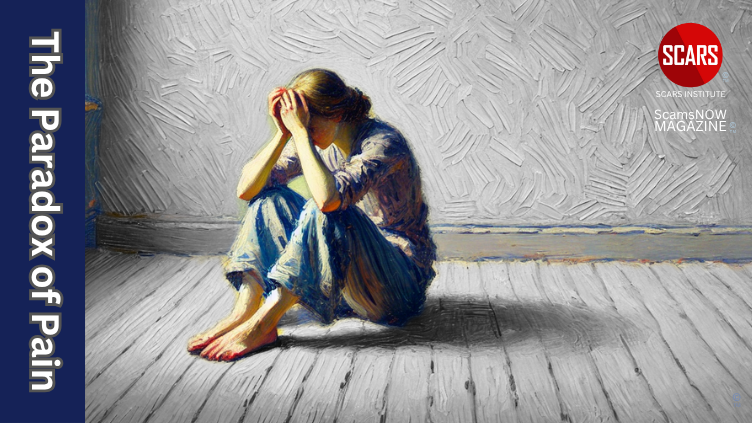
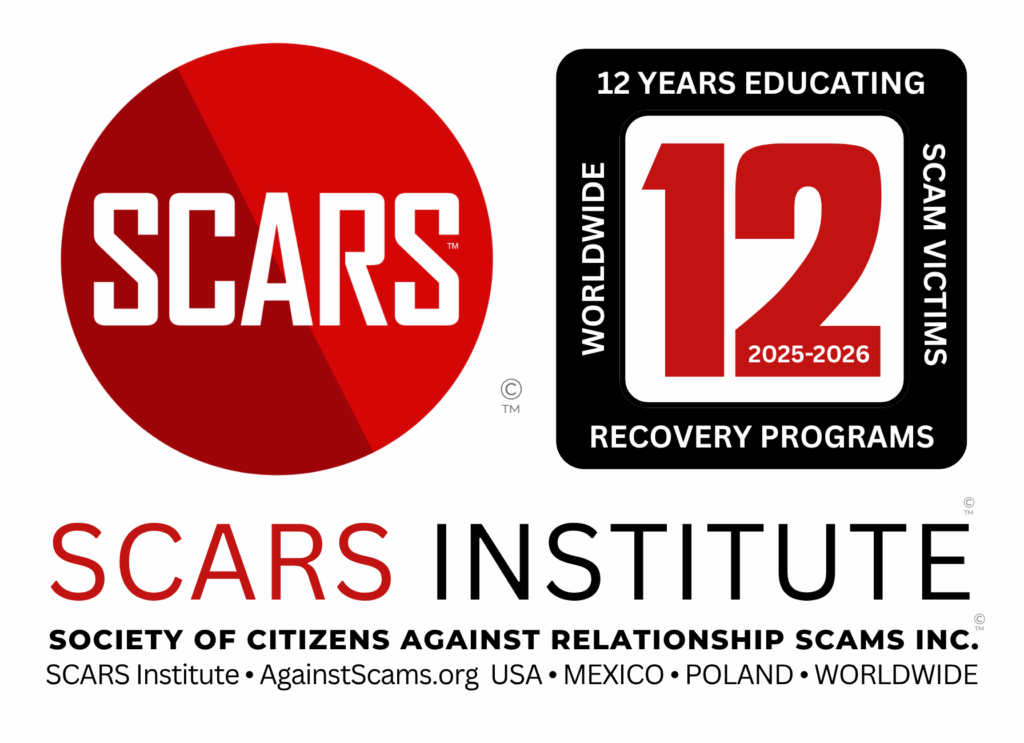




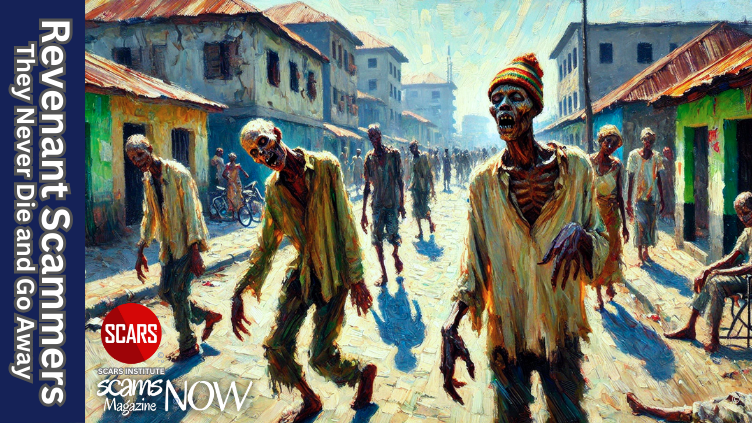
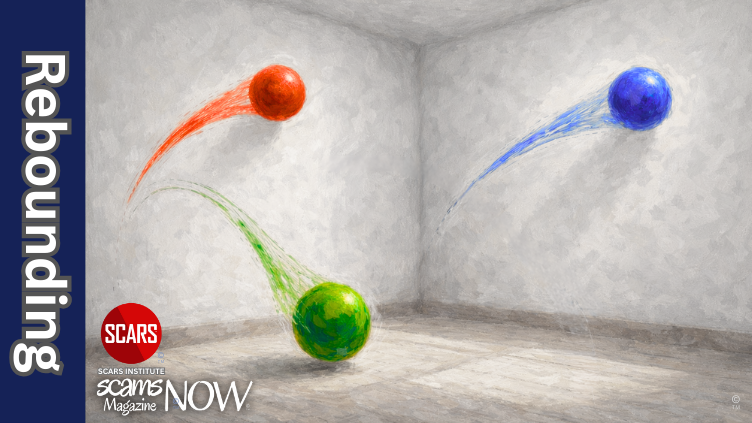


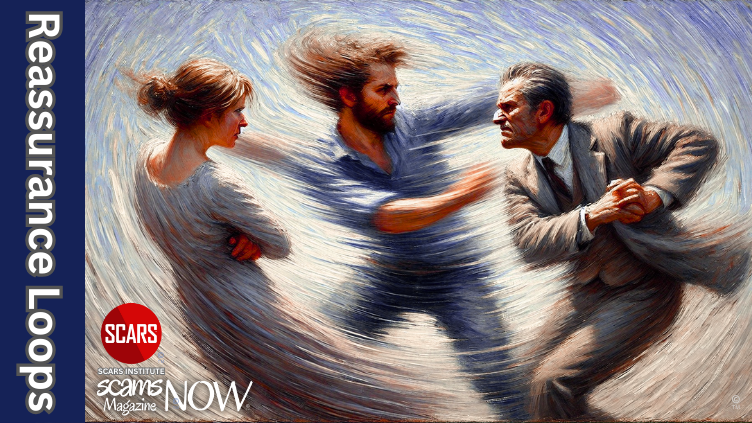
![NavyLogo@4x-81[1] The Paradox of Pain - 2025](https://scamsnow.com/wp-content/uploads/2025/04/NavyLogo@4x-811.png)

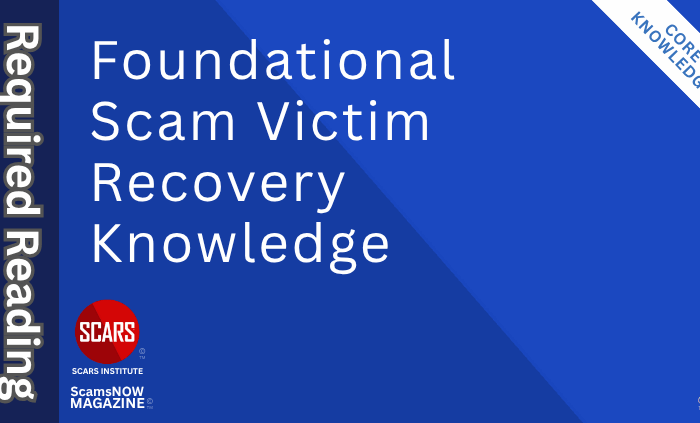


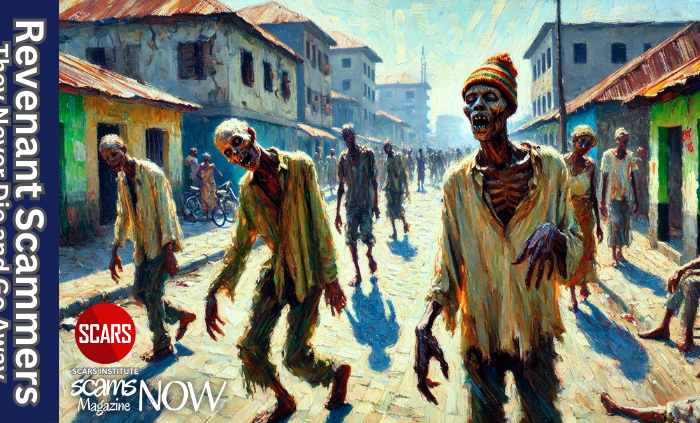
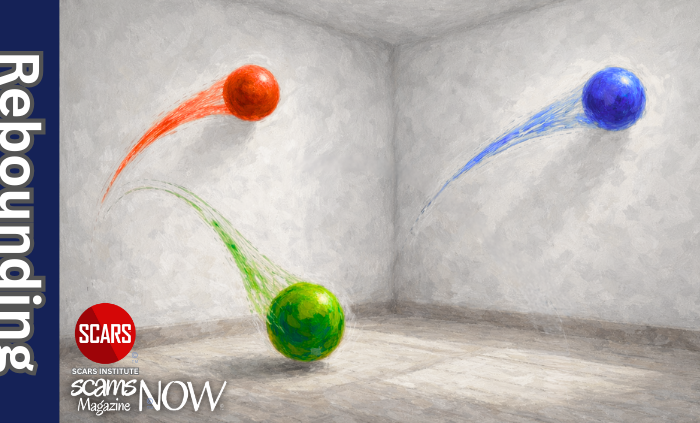


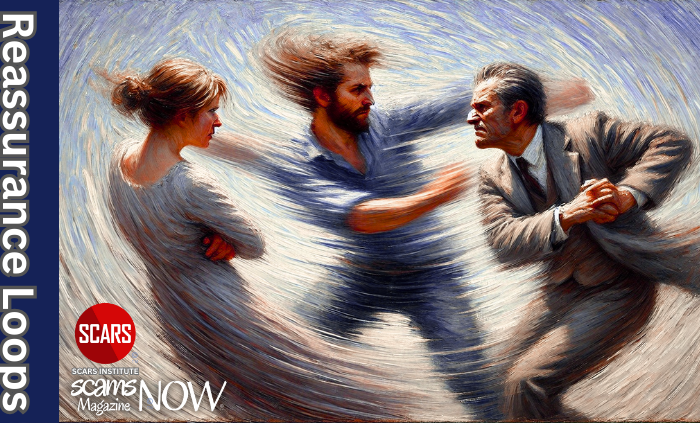
![scars-institute[1] The Paradox of Pain - 2025](https://scamsnow.com/wp-content/uploads/2025/04/scars-institute1.png)

![niprc1.png1_-150×1501-1[1] The Paradox of Pain - 2025](https://scamsnow.com/wp-content/uploads/2025/04/niprc1.png1_-150x1501-11.webp)

This is a great article and holds significance for me. Initially after my crime I felt such pain. It would come in waves. I would find tears running down my face and my heart pounding with the pain I felt. As time went on others around me became frustrated with me voicing the complaint “just get over it would ya!” So I hid my pain. Then I had people trying to fix me. They said I had to return to the “land of the living”. Our society seems totally uncomfortable with a person expressing their pain and grief. Eventually with the help of my therapist I learned just as the article suggests to schedule releasing my pain and grief. There are other things I’m working besides recovery from my crime. By scheduling my pain/grief time those around me seem more comfortable.